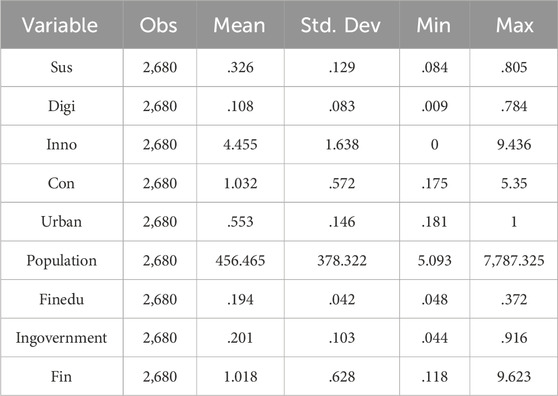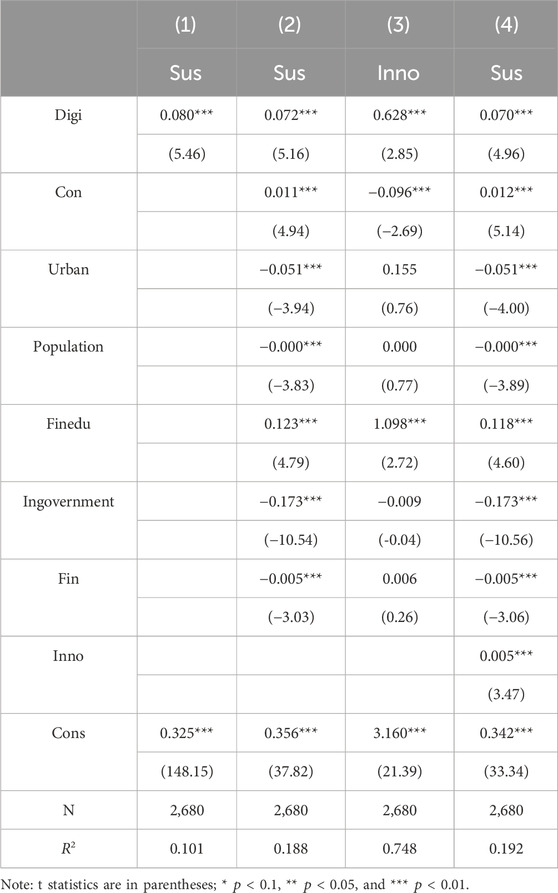- 1School of Statistics and Mathematics, Shandong University of Finance and Economics, Jinan, China
- 2Israel Branch, University of International Business and Economics, Petah Tikva, Israel
This research investigates the intricate interplay among the digital economy, green innovation, and the level of sustainable development. Panel data from 268 cities in China, from 2011 to 2020, are used to comprehensively evaluate the level of digital economy development and investigate the digital economy’s influence on sustainable development. Additionally, a mechanism analysis is used to investigate the contribution of green innovation. The findings suggest that the digital economy significantly stimulates sustainable development, and green innovation serves as a mediating intermediary and moderating effect in facilitating this relationship. Moreover, the robustness check extends the verification of the positive effect of the “Broadband China” policy on sustainable development, strengthening the reliability of the results. The contribution of this study provides management insights on how regions can promote sustainable development in the digital age.
1 Introduction
Since the United Nations adopted the “2030 Agenda for Sustainable Development” in 2015, nations worldwide have been endeavoring to tackle context-specific challenges in pursuit of achieving a harmonious equilibrium among economic factors, resource utilization, and social equity. In the present, the rapid expansion of the digital economy, notably in domains like artificial intelligence and blockchain, has emerged as a new driver for national economic growth (Horoshko et al., 2021; Pang et al., 2024). In the digital economy era, the digital economy’s significance for regional green development has been validated in related literature (Gao et al., 2022; Hosan et al., 2022; Cai, 2023; Zheng and Wong, 2024). The digital economy accelerates knowledge spill-over and information exchange within innovation networks. Corporations capitalizing on cutting-edge technologies experience cost efficiencies, in this way, driving both technological renewal and facilitating a shift towards environmentally sustainable and greener production (Han et al., 2023).
Additionally, the digital economy transcends conventional temporal and spatial constraints, facilitating the intensive integration and efficient utilization of production elements (Miao, 2021; Gao et al., 2022; Liang and Tan, 2024). Consequently, the digital economy boosts economic returns and pro-motes sustainable growth. Indeed, the extent of China’s progress in developing its digital economy industry is considerable, with robust growth momentum. However, evident issues also exist, such as an incomplete digital economy institutional system, inadequate and imbalanced infrastructure, and an imperfect legal environment. These divergences deviate from the nation’s strategic objectives, namely, consolidating economic growth, fostering innovation, and promoting sustainable development by advancing the digital economy. During the digital economy’s development, these challenges have somewhat acted as barriers to achieving green and sustainable progress. Consequently, it is imperative to conduct a profound study on how to boost the digital economy and achieve sustainable development. Specifically, there is a need to develop an under-standing of the paths to realizing sustainable growth within the digital realm and delve into the theoretical mechanisms driving the digital economy.
Considering the above context, this paper comprehensively constructs the indicators to evaluate sustainable development and digital economy index by several dimensions. This research employs panel data from urban level in China, spanning the period from 2011 to 2020, to investigate the impact of the digital economy on sustainable development. The main contributions of this study are as follows. This paper explores theoretical mechanisms and implementation pathways, analyzing existing literature to elucidate how the digital economy can promote sustainable development. This paper provides theoretical justification and empirical evidence for the development of China’s digital economy and sustainable development. Furthermore, the study employs a comprehensive indicator evaluation method to measure the levels of digital economy and sustainable development. This evaluation method enriches the concept of sustainable development and offers a Chinese approach to achieving the 2030 Agenda for Sustainable Development. Additionally, this paper utilizes city-level panel data, overcoming the limitations of previous research that relied on provincial-level panel data with smaller sample sizes, thereby improving the accuracy of empirical results. Moreover, the “Broadband China” policy is used as an exogenous shock to ascertain the net effect of digital policy on sustainable development. This approach addresses endogeneity issues and enhances the robustness of the research findings. Moving forward, this research aims to extend the applicability of conclusions globally by analyzing data across various countries and regions. This research will also broaden the concept of sustainable development beyond just economic and environmental sustainability, incorporating the United Nations’ 17 Sustainable Development Goals.
2 Literature review
The new characteristics of the digital economy have profoundly led to new economic activities and patterns. Firstly, the data-oriented essence of the digital economy is manifested through vast information displays, convenient information retrieval, and near-zero replication costs. This clearly reflects an economic and societal development model powered by data. Secondly, non-linear innovation patterns, rapid product iteration (Goldfarb and Tucker, 2019), and the decentralization of organizations now characterize the integrative innovation trait under digital technology. Thirdly, the digital economy’s networked and plat-form-based nature demonstrates open-sharing characteristics (Hukal et al., 2020; Sandberg et al., 2020). Technologies like the Internet, blockchain, and big data reinforce inter-industry network effects and challenge the traditional boundaries within industries. The potential for collaboration offered by the virtual world has prompted businesses to explore the establishment of convenient and economically efficient virtual global workplaces. In research, the wide-spread application of digital technology has paved new avenues for economic analysis and forecasting. Therefore, in this new development phase, the focus of research on sustainable socio-economic development revolves around how to efficiently utilize in-formation technology, effectively allocate digital resources, harness the digital economy to foster innovation, and how to propel high-quality economic growth.
Economic sustainability is bolstered by the presence and influence of the digital economy. Firstly, the digital economy has enhanced economic efficiency compared to traditional economies, improved the economic structure, and deeply integrated with the real economy (Gao et al., 2022; Niu et al., 2024). The transformation brought about by the digital economy in the efficiency, momentum, and standard of economic growth is an indispensable element in maintaining China’s ongoing sustainable economic development. Specifically, the digital economy can enhance the efficiency of pairing supply with demand. At the macro level, the digital economy can move the production point closer to the production possibility frontier and push the frontier outward, thus optimizing factor proportions and increasing allocation efficiency (Nambisan et al., 2019; Sanders et al., 2019; Mishra et al., 2022). A body of research have highlighted the positive impact of digital economy on societal production efficiency (Zhang T. et al., 2022b), employment and entrepreneurial promotion (Wu and Yang, 2022), and industrial structure upgrades (Wang and Chen, 2024). Secondly, the digital economy possesses inclusive effects, spillover effects, and synergistic effects, towards mitigating the disparities among urban-rural areas, regions, and industries. Digital inclusive finance has improved entrepreneurial behavior among rural residents, helping to equalize entrepreneurial opportunities and thereby reducing urban-rural disparities (Xie et al., 2020; Li, 2024). The diffusion of digital technology has also strengthened the links between urban and rural economic activities and inter-regional activities. The digital economy drives economic growth in neighboring areas through spatial spillover effects, consequently facilitating coordinated development among regions. Furthermore, the digital economy relies on the synergy of “industrial digitalization” and “digital industrialization”, as well as the collaboration of industrial and supply chains. This creates a shared tech-resource industrial interconnected ecosystem, which propels the transformation and upgrade of industrial and supply chains, thereby promoting coordinated development between industries (Wignaraja et al., 2016).
Additionally, the digital economy contributes to the promotion of environmental sustainability. Specifically, this research outlines the influence of the digital economy on the sustainability of the environment through three specific viewpoints. Firstly, there is the perspective of corporate green production. Corporations, being the primary agents in pollution mitigation, have the option to utilize technological innovations such as virtual reality, databases, and the Internet of Things, which have emerged from the advancements in the digital economy. These advances allow them to effectively integrate various informational resources in production decisions, mitigating issues related to fragmented and asymmetric data. By analyzing product, process, and resource data, the firms can streamline production processes, boost productivity, and reduce resource wastage, ultimately supporting green and sustainable development (Viturka et al., 2013; Jiang et al., 2022; Guo et al., 2023). Secondly, there is the perspective of governmental environmental regulatory models. As China’s economy continuously grows and ecological issues become more intricate, ecological environmental supervision faces increasing challenges. Traditional regulatory models are grappling with deficiencies in regulatory supply, outdated measures, and low efficiency. The digital economy provides both a robust opportunity and a technical foundation upon which these challenges can be rectified. The real-time evaluation of environmental parameters such as air quality or pollutant emissions is enabled by the progress in big data and cloud computing driven by the digital economy, in addition to the utilization of remote sensing techniques (Liu et al., 2017; Chen et al., 2018; He et al., 2020; Li, 2024). This, in turn, enhances early-warning capabilities and improves the precision and effectiveness of governmental environmental regulation, leading to higher ecological governance standards. Thirdly, there is the perspective of social environmental oversight mechanisms. The public, characterized by its vast distribution, influential power, and swift awareness, can play a pivotal role in environmental supervision. Through oversight, feedback and public opinion, the public shoulders social responsibility for environmental oversight, collaborating with administrative entities to counter environmental pollution threats (Dzwigol et al., 2023). The convergence of these three perspectives leads to the conclusion that the digital economy concurrently promotes both economic development and environmental sustainability.
Summarizing the literature since 2022, most scholars have focused on the impact of the digital economy on energy efficiency (Wang and Shao, 2023), carbon emissions (Niu et al., 2024), high-quality development (Liang and Tan, 2024) and so on in the context of China. However, there is a relatively little of research that integrates the 2030 Agenda for Sustainable Development with the study of China’s sustainable development. Moreover, most of studies rely on provincial-level panel data, which often involves a smaller sample size. Although the previous studies examining the link between the digital economy and sustainable development, pressing questions remain. For example, does the digital economy’s promotion of sustainable development exhibit a nonlinear relationship? Also, what is the transmission mechanism? In line with this thinking and building upon existing literature, this study uses city-level panel data from 2011 to 2020. Various econometric approaches are employed to delve more profoundly into the digital economy’s role in advancing shared prosperity. The essence of the digital economy is in the development and application of information and communication technologies, which are themselves products of innovation. The digital economy, through online platforms and social media, accelerates the spread of knowledge and information. This spread rapid exchange of information fosters interdisciplinary and cross-sectoral collaboration, speeding up the innovation process (Luo et al., 2023). Thus, the digital economy provides a powerful impetus and a platform for innovation by promoting technological advancement and enhancing the flow of information. Scholars have already investigated the impacts of innovation on economic growth (Pradhan et al., 2020), environmental pollution (Shahzad et al., 2020), and sustainable development (Yuan and Zhang, 2020). Moreover, in studies similar to this paper, some scholars have treated green innovation as a mediating variable (Zhang J. et al., 2022a; Pan et al., 2022). So, green innovation is introduced as a mediating variable to examine the transmission mechanism linking the digital economy’s influence on sustainable development.
3 Theoretical analysis and research hypotheses
Sustainable development can be divided into economic sustainability and environmental sustainability. The digital economy, based on digital technology and data, is continuously permeating various aspects of society. There is an urgent need to augment the penetration effect of digitization on the economy, uphold innovation-led approaches, and foster sustainable development through the influence of digital means on innovative elements. This section delves into the mechanisms and non-linear effects that link the digital economy to sustainable development; relevant research hypotheses are also put forward. The Conceptual framework see Figure 1.
3.1 The mechanistic pathway
Scholars have indicated the ability of digital economy to nurture economic sustainability. Firstly, the development of the digital economy enhances the efficiency, convenience, and intelligence of economic activities. This in turn reduces production and operational costs, increases production efficiency and competitiveness, creates more job opportunities, elevates labor productivity, and consequently improves income levels (Zhang T. et al., 2022b; Wu and Yang, 2022). Furthermore, the digital economy propels societal specialization and industry upgrades, refining economic structures and fostering innovation (Chen et al., 2022). This facilitates a quicker and deeper transition of traditional industries toward digitization and automation, providing new impetus and growth vectors for economic expansion. Additionally, the digital economy significantly accelerates urbanization processes. Information and resource distribution become more efficient and rapid, geographical and temporal barriers are diminished, and subsequently, urbanization rates are enhanced, while urban-rural income disparities are narrowed (Xie et al., 2020; Zhang et al., 2023).
Moreover, there are assertions from other scholars highlighting the capacity of the digital economy to enhance environmental sustainability. Firstly, the extensive utilization of digital technology has the potential to elevate production efficiency and optimize resource utilization, consequently fostering the digital transformation of industries and subsequently mitigating environmental pollution and resource depletion. Furthermore, the digital economy facilitates the growth of energy transition and green economy, thereby propelling the construction of a low-carbon, circular, and ecological economy (Ulucak et al., 2020).
The green innovation driven by the digital economy promotes sustainable development. Firstly, green technological innovation facilitates the mobility of production factors and the efficient resource consolidation, thus optimizing economic performance and bolstering economic sustainability. Secondly, the digital economy inherently aligns with eco-friendly industries. The digital economy’s green innovations can reduce carbon dioxide emissions, stimulate green economies’ growth, radically change the traditional high-polluting, high-energy consuming industries, and catalyze environmental sustainability.
H1. The digital economy promotes sustainable development through green innovation.
3.2 The non-linear effect of the digital economy
First and foremost, the digital economy’s growth trajectory is non-linear. In the early phases of the digital economy, infrastructure costs were high, with only a few locations receiving the benefits of digitization. This limited the digital economy’s potential to fuel sustainable growth. However, as the digital economy has grown, so has the networked economic model, resulting in significant network externalities. This means that customer purchasing decisions are now being influenced, not only by their own tastes, but also by the purchasing dynamics of their peers. These network externalities fundamentally originate from networks’ systemic nature and intrinsic interactivity. Assume that positive network externalities rule the digital economy. In that situation, those externalities may cause the “Matthew effect,” a positive feedback loop inside the network system that leads to self-expanding consumption scales and, as a result, “demand-side economies of scale.” As consumption expands, network externalities show a growing marginal utility trend, contradicting mainstream economic theories’ declining marginal utility principle.
Second, the digital economy’s impact on multiple economic entities is inherently non-linear. For economic entities, the cost to adopt data elements and digital technology gradually falls as the digital economy’s penetration into the real economy increases. This effectively breaks the traditional restrictions of finite resource supply on growth (Mak and Max Shen, 2021). The benefits of the digital economy are rapidly growing, prompting many economic organizations to embrace digital technologies. As the digital economy and innovation levels advance, this effect grows more pronounced.
The essence of the digital economy lies in its deep integration with the real economy through digital technologies and the dissemination of innovation across all facets of the socio-economic landscape. The level of innovation, in turn, is the pivotal element driving the evolution of the digital economy. Under the constant positive feedback loops, the digital economy will eventually become an even more robust impetus for sustainable development modulated by innovation levels.
H2. A non-linear relationship exists between the digital economy and sustainable development.
4 Research design
4.1 Model construction
4.1.1 Mediating variable model
To verify the direct impact of the digital economy on sustainable development, this study constructs the following benchmark model:
The sustainable development index for city
Hypothesis 1. postulates that the digital economy can indirectly influence sustainable development by promoting the level of green innovation. This study conducts the following tests to determine whether the level of innovation acts as a moderating variable in the digital economy’s support of sustainable development: On the significant foundation of the fixed panel regression coefficient
4.1.2 Threshold regression model
Formula (1) studies the linear effect of the digital economy on sustainable development using a fixed panel model. In real-world data, many relationships are not merely linear but change under specific conditions or levels. Threshold models, by setting one or more threshold values, can effectively identify and model these change points. These models divide the data according to certain “threshold values” into different regions, assuming different linear relationships between variables within each region, thus describing the nonlinear relationships between variables using economic terminology. To test Hypothesis 2, this study establishes the following panel threshold model:
Equation 4 represents the single threshold model, where
4.2 Measurement and elucidation of variables
4.2.1 Measurement of the digital economy
Drawing on the methodology by (Zhao et al., 2020), five indicators are used to measure the level of the digital economy, as shown in Table 1. Digital infrastructure is the foundation for the advancement of the digital economy, with key factors including the prevalence of the internet and the number of mobile internet users. An increase in internet penetration signifies greater access for people to the internet, enabling them to enjoy the conveniences brought by digital information technology and reducing the digital divide. The convenience and flexibility of mobile internet allow users to access the network anytime and anywhere, accelerating the development of the digital economy. Therefore, enhancing internet penetration and increasing the number of mobile internet users are crucial for promoting the growth of the digital economy, both serving as positive indicators. Industry digitalization refers to sectors deeply integrated with digital technology. Currently, the financial sector is closely merged with digital technology, it is reasonable to represent the level of industry digitalization using the digital inclusive finance index. Digital industrialization refers to industries associated with digital technologies, services, and applications, constituting a significant segment of the digital economy. It denotes the process of applying digital technologies to traditional industries to achieve digitization and intelligentization of industries. Thus, this article employs per capita telecommunications business volume and the number of people employed in internet-related sectors as metrics, both of which are positive indicators. To determine the level of digital economic development, weights must be assigned to the relevant indicators. Subjective and objective approaches to weight assignment are common. Human biases may have a significant influence on subjective methods, resulting in potential discrepancies during indicator weighting. To avoid the inaccuracies typically caused by subjective weight assignment, the entropy method, an objective weighting approach, is used to assign weights to the five indicators employed in this study. This culminated in the digital economic development index for Chinese cities, from 2011 to 2020, denoted as
4.2.2 Measurement of sustainable development
Sustainable development refers to meeting the needs of the present generation without compromising the ability of future generations to meet their own needs. This involves a balance between the efficient use of resources, environmental protection, and long-term economic growth. From an economic sustainability perspective, sustainable development ensures prolonged economic growth and stability, not only meeting today’s economic demands but also ensuring that future generations can meet their economic needs. Environmental sustainability focuses on how to reduce negative impacts on the environment while achieving economic growth and simultaneously ensuring the health and stability of ecosystems. This requires quantifying measures of resource consumption, pollution emissions, and biodiversity. Only when both economic and environmental dimensions achieve sustainability can a nation or region be said to have genuinely achieved sustainable development. In summary, to avoid overlooking essential indicators and to prevent excessive correlation among indicators, 11 indicators were chosen, as shown in Table 2. Using the entropy method, weights were assigned to these sustainable development indicators, resulting in a sustainable development level index for cities from 2011–2020, denoted as
4.2.3 Mediator and control variables
This study measures green innovation (
Sustainable development is influenced by other factors, including the sophistication of industrial structure (
4.3 Descriptive statistics
Table 4 provides descriptive statistics for the main variables in this study. The average value for sustainable development level is 0.326; the maximum value is 0.805, and the minimum value is 0.084. This indicates a significant disparity in the levels of sustainable development. Similarly, the levels of digital economy and green innovation also demonstrate heterogeneity among cities.
5 Empirical analysis
5.1 Benchmark regression outcomes
Table 5 presents the linear estimation results. The results in Columns (1) and (2) show that the coefficient of the
H1 studies how the digital economy promotes sustainable development from the perspective of green innovation. This study uses a mediation model to test the mediating effect of the digital economy, as shown by the results in Columns (3) and (4). Based on the results in Column (2), which confirms that the digital economy promotes sustainable development, the results in Column (3) check whether the digital economy boosts green innovation. The findings show a significant positive impact at the 1% level and the regression coefficient is 0.628, meaning the digital economy significantly enhances green innovation levels. When introducing the innovation level variable into the regression model, the results in Column (4) show that the coefficient of the digital economy is 0.070 lower than in Column (2). This suggests that green innovation acts as a mediating mechanism in the influence of the digital economy on sustainable development, confirming H1.
5.2 Non-linear effects
This study also uses a panel threshold model for analysis, specifically to confirm the non-linear impact of the digital economy on sustainable development, as shown in Table 6. Both the threshold variables for the digital economy and green innovation level passed the single threshold test.
Firstly, from the results in Column (1), it is evident that when the level of the digital economy is below the threshold value of 0.171, the regression coefficient of the digital economy is 0.183. However, when the level of digital economy development exceeds the threshold, the coefficient becomes 0.109. The results are evident that the digital economy displays a characteristic of having a positive but diminishing impact on sustainable development. Secondly, in Column (2), where green innovation acts as the threshold variable, when the level of the green innovation is below the threshold value of 6.107, the regression coefficient of the digital economy is 0.042. However, when the level of green innovation exceeds the threshold, the coefficient becomes 0.163. The result shows that the impact of the digital economy on sustainable development is influenced not only by intrinsic effect but also by the moderating effect of the green innovation level. Under this moderating effect, the promoting role of the digital economy on sustainable development gradually strengthens, which is consistent with H2.
The explanation provided in this study is as follows: In theory, the digital economy can improve the digital factor market’s matching capability. Precise alignment of factors and information can boost market vitality, productivity, and economic growth, and can also reduce pollution. All of this serves to advance sustainable development. Digital factors are like but distinct from technological and capital factors. When economic growth is dependent on the accumulation of digital factors in the early stages of exploration, diminishing returns can constrain long-term growth, resulting in a reduced promotion effect. In the long run, with the support of the evolving digital economy, digital innovation can overcome spatial and temporal constraints. As these factors transition across various technological application sectors, the levels of technical and organizational innovation continually rise, feeding back into the digital elements. This enhances the positive impact of the digital economy on sustainable development. This feedback loop in turn naturally results in a progressively strengthening role of the digital economy in promoting sustainable development.
5.3 Heterogeneity analysis
During the sampled years, China’s eastern and western regions exhibited pronounced disparities in resource endowments, levels of innovation, and economic development. Consequently, the relationship between the digital economy and sustainable development likely manifests regional heterogeneity. The detailed outcomes are shown in Table 6.
Table 7 indicate that the coefficients for the digital economy are consistently positive. This finding suggests that digital economy advancements facilitate sustainable development across the eastern, central, and western regions. However, with the eastern region’s coefficient being significant at 0.115, with the others being less than 0.115, it is evident that regional heterogeneity clearly exists in terms of how the digital economy contributes to shared prosperity in China. Two plausible explanations are as follows:
Variation in development levels: Because the eastern region is more advanced than its central and western counterparts, the eastern region is likely to have a superior digital economic infrastructure, more sophisticated technology adoption, and a better talent ecosystem. This causes and allows businesses and residents in the eastern region to use new technological innovations more efficiently, thereby capitalizing on the digital economy for sustainable development. In contrast, the central and western regions may be somewhat encumbered by deficiencies in digital infrastructure and technological adaptability. This mutes the potential positive implications of the digital economy on those regions’ sustainable development trajectory.
Divergences in policy and resource allocation: Because of the eastern region’s economic prominence, that region may be more susceptible to attracting policy support and resource investments tailored to the digital economy. This effectively amplifies the digital economy’s role in propelling sustainable development. Conversely, due to their resource and financial constraints, the central and western regions may need to prioritize or invest more heavily in the digital economy, resulting in a relatively muted impact on sustainable development.
6 Robustness tests
6.1 Variable replacement and lag regression
As shown in Table 8, by substituting the primary explanatory variable, this study re-calculates and regresses the digital economy development Index (
6.2 External shock test
In 2013, the State Council issued the “Notice of the State Council on the Issuing of the Broadband China Strategy and Implementation Plan.” Based on this notice, three batches of cities were chosen as pilot cities in 2014, 2015, and 2016. Once a city was selected as a pilot site, efforts were increased to improve broadband speed and network coverage. In this study, the chosen cities are designated as the treated group impacted by the policy. Meanwhile, the cities that were not selected serve as the control group. The multi-period DID model is used to calculate the net impact of the “Broadband China” pilot policy on long-term development.
In these formulas 5–7,
As shown in Table 9, the results with added control variables in Column (1) show that the regression coefficient is 0.007, indicate that the “Broadband China” policy significantly promotes sustainable development, being significant at the 1% statistical level. The positive effects might stem from the following: The “Broadband China” pilot policy optimizes urban network infrastructure, thereby breaking through traditional barriers in the transmission, reception, and transformation of innovative information. The accumulation of green innovation achievements and innovative talents also lays a solid foundation for the development of the digital economy, further promoting sustainable development. Column (2) suggests that “Broadband China” has a significant positive impact on green innovation and the regression coefficient is 0.029. The results in Column (3) indicate that, after incorporating the mediating variable, the coefficient on ‘policy’ decreases slightly, whereas the coefficient on green innovation level is significantly positive. This finding shows that innovation serves as a mediating variable in the policy’s effort to bolster shared prosperity. The research conclusions in this section support H1, demonstrating the robustness of the baseline regression results.
7 Discussion
This paper conducts an empirical analysis of Chinese urban panel data, from 2011 to 2020, resulting in the following discussion:
First, this study uses the entropy weight method to measure the levels of both the digital economy and sustainable development. Following that, empirical research is conducted to determine the impact of the digital economy on sustainable development. After conducting baseline regressions and several robustness checks, the conclusion is reached that the digital economy can promote sustained growth. This finding is consistent with the results of Zhang (2021) and Xu et al. (2023). Zhang employed a set of 12 indicators to measure the development of the digital economy at the provincial level in China. The study also utilized a singular metric, total factor productivity, to gauge the high-quality development of the economy. Xu validated the synergistic development between the digital and green economies using an LSTM-GM model. Using urban data, this paper employs various econometric models to examine the relationship between the digital economy and sustainable development, offering a larger sample size for analysis. Moreover, Savchenko and Borodina (2020) provided a classification system for sustainable development objectives that advocates integrating digital solutions to promote urban sustainability. Alenkova et al. (2020) examination revealed how digitalization catalyzes eco-innovation within production enterprises, leading to the adoption of green practices. Collectively, these studies affirm the transformative influence of the digital economy in the context of sustainable development.
Second, the digital economy promotes sustainable development by enabling green innovation. The findings of this study are consistent with those of (Li et al., 2022). Note that many scholars have focused solely on the mediating effects of green innovation, with few examining its moderating effects. By contrast, employing a threshold model to examine moderation, this study demonstrates that the digital economy promotes green innovation through domestic technology transfers, intellectual property protection, and industry-academia-research collaboration. In turn, this study finds that the development of the digital economy is a new form of economic growth driven by technological in-novation. As a result, green innovation can help the digital economy grow. It is precisely such a positive feedback loop, under the moderating effect of the level of green innovation, that enables the digital economy to enhance sustainable development with a marginal increasing effect.
Third, the development of the digital economy often depends on numerous factors, which in turn profoundly impact sustainable development. Therefore, this paper uses the “Broadband China” pilot policy as an exogenous policy shock to examine the impact of the digital economy on sustainable development. The results of this study are consistent with prior research (Zhang, 2021; Zou and Pan, 2023), indicating that the “Broadband China” pilot policy can further facilitate sustainable development. This study also attempts to use the “National Com-prehensive Big Data Pilot Zones” as a factor to affect the digital economy (Wei et al., 2023; Zhang and Ran, 2023); other research has only focused on the policy’s impact on carbon emissions, without considering its effects on the economic system. The findings of this study suggest that the “National Comprehensive Big Data Pilot Zones” policy is not conducive to sustainable development in China. This may be due to the “Broadband China” policy directly promoting information and communication technology and efficiency of information transmission, thus facilitating sustainable development. In contrast, the “National Comprehensive Big Data Pilot Zones” policy may be overly-focused on the development of the big data industry, while not fully considering how to integrate big data with the objectives of sustainable development.
The contributions of this paper are threefold. First, the study investigates the theoretical mechanisms and implementation pathways through which the digital economy promotes sustainable development. While many articles have only considered the impact of the digital economy on economic growth, innovation, or carbon emissions, this paper examines the relationship from economic and environmental sustainability perspectives through the effects of green innovation. Second, this paper constructs evaluation indicators for the digital economy and sustainable development at the urban level. The mediating and moderating effects of green innovation are also discussed in detail. Additionally, the “Broadband China” policy is utilized for an exogenous shock test. The aim of the test is to identify the net impact of digital economy development on sustainable development, thereby mitigating endogeneity issues and enhancing the robustness of the results.
Despite efforts to ensure the reliability of the empirical results, the authors acknowledge that this study has some limitations. As with any empirical research, endogeneity issues and omitted variables may have an impact on the causal interpretation of the findings. Endogeneity issues typically refer to the correlation between explanatory variables and the error term in a model, which may arise from bidirectional causality, omitted variables, or measurement errors. For instance, the development of the digital economy might enhance the level of sustainable development, while at the same time, a higher level of sustainable development could further promote the progress of the digital economy, thereby creating a bidirectional causal relationship. Moreover, if important variables such as policy environment or education level are overlooked in the study, it could lead to inaccurate estimates of the impact of the digital economy on sustainable development. These problems ultimately affect the validity and reliability of the research conclusions, making it challenging to accurately assess the true impact of the digital economy on sustainable development, thereby influencing policymaking. As a result, additional research, using advanced methods, panel data, and quasi-natural experiments, could help to elucidate the causal mechanisms at work. Furthermore, because this study is primarily focused on Chinese cities, we must acknowledge that the political environment may have an impact on Chinese city sustainability issues. China is a vast and diverse country, with distinct political, economic, and environmental policies. As a result, some of the findings of this study may be influenced by local political contexts. For example, in some areas, the government may place a greater emphasis on high-quality development and environmental protection policies, thereby promoting the level of sustainable development in those areas. In contrast, in less developed regions, the focus may be solely on economic growth, with economic and environmental sustainability virtually ignored.
Moving forward, the authors intend to broaden the applicability of this article’s conclusions by analyzing data from various countries or regions at a global level. Future, this paper will also expand the definition of sustainable development, not only limiting the definition to economic and environmental sustainability but also integrating the term with the United Nations’ 17 sustainable development goals.
8 Conclusion and policy implications
Using urban-level panel data from China, between 2011 and 2020, this study creates evaluation indices for China’s digital economy and sustainable development levels. The research analyzes the influence mechanism of the digital economy on sustainable development by using fixed panel models, difference-in-differences models, mediating effect models, and threshold models. The following findings are obtained: First, the digital economy promotes sustainable development by advancing green innovation. This suggests that the digital economy helps improve China’s green innovation levels, acting as a catalyst for long-term development. That finding remains robust, even after accounting for the exogenous shock from the “Broadband China” policy. Second, the role of the digital economy in boosting sustainable development becomes progressively more pronounced under the moderating effect of innovation levels. Third, regional heterogeneity exists in the impact of the digital economy on sustainable development. While the digital economy significantly promotes sustainable development in the eastern regions of China, the same effect is not evident in the central and western regions.
Drawing from the above conclusions, this paper offers the following policy implications:
First, there is a critical need to strengthen the technological foundation of the digital economy and to continue to deepen the integration of the digital and physical economies. The government should increase investment in digital infrastructure, fortify the digital economy’s technological foundation, and fully harness and solidify the advantages brought about by the growth of the digital economy. Furthermore, traditional industries should be encouraged and guided to undergo digital transformation, allowing firms to use digital technologies for efficiency gains.
Second, given the regional disparities in digital economic development, implementing differentiated digital economic policies is urgently required. Cities should develop their digital economies based on their own specific economic conditions. For cities with relatively lower levels of digital economic development, especially those in the central and western regions and peripheral areas, higher-level governments should provide more policy incentives, accelerating the construction and enhancing the coverage of digital infrastructure.
Third, it is essential to explore the various ways the digital economy can drive sustainable development and to fully leverage the mediating effects of green innovation. The government should increase investment in science and education, enhance the quality of green innovation talent cultivation, reinforce intellectual property rights protection, and fully unleash the vitality of green innovation.
Data availability statement
The original contributions presented in the study are included in the article/Supplementary Material, further inquiries can be directed to the corresponding author.
Author contributions
QA: Conceptualization, Investigation, Writing–original draft, Writing–review and editing, Funding acquisition. RW: Formal Analysis, Methodology, Writing–original draft, Writing–review and editing. YW: Methodology, Writing–original draft. KP: Writing–review and editing.
Funding
The author(s) declare financial support was received for the research, authorship, and/or publication of this article. This research was funded by Shandong Province Social Science Planning Fund Program, grant number (23CJJJ20).
Conflict of interest
The authors declare that the research was conducted in the absence of any commercial or financial relationships that could be construed as a potential conflict of interest.
Publisher’s note
All claims expressed in this article are solely those of the authors and do not necessarily represent those of their affiliated organizations, or those of the publisher, the editors and the reviewers. Any product that may be evaluated in this article, or claim that may be made by its manufacturer, is not guaranteed or endorsed by the publisher.
References
Alenkova, I. V., Mityakova, O. I., Mityakov, S. N., and Ivanov, S. S. (2020). “Digital economy: new opportunities to implement eco-innovations at production enterprises,” in III International Scientific and Practical Conference “Digital Economy and Finances” (ISPC-DEF 2020) (Atlantis Press), 108–111. doi:10.2991/aebmr.k.200423.023
Cai, S. (2023). Impact of digitization on green economic recovery: an empirical evidence from China. Econ. Change Restruct. 56, 3139–3161. doi:10.1007/s10644-022-09473-6
Chen, S., Ding, D., Shi, G., and Chen, G. (2022). Digital economy, industrial structure, and carbon emissions: an empirical study based on a provincial panel data set from China. Chin. J. Popul. Resour. Environ. 20, 316–323. doi:10.1016/j.cjpre.2022.11.002
Chen, Z., Kahn, M. E., Liu, Y., and Wang, Z. (2018). The consequences of spatially differentiated water pollution regulation in China. J. Environ. Econ. Manag. 88, 468–485. doi:10.1016/j.jeem.2018.01.010
Dzwigol, H., Kwilinski, A., Lyulyov, O., and Pimonenko, T. (2023). The role of environmental regulations, renewable energy, and energy efficiency in finding the path to green economic growth. Energies 16, 3090. doi:10.3390/en16073090
Gao, D., Li, G., and Yu, J. (2022). Does digitization improve green total factor energy efficiency? Evidence from Chinese 213 cities. Energy 247, 123395. doi:10.1016/j.energy.2022.123395
Goldfarb, A., and Tucker, C. (2019). Digital economics. J. Econ. Literature 57, 3–43. doi:10.1257/jel.20171452
Guo, B., Wang, Y., Zhang, H., Liang, C., Feng, Y., and Hu, F. (2023). Impact of the digital economy on high-quality urban economic development: evidence from Chinese cities. Econ. Model. 120, 106194. doi:10.1016/j.econmod.2023.106194
Han, J., Sun, R., Zeeshan, M., Rehman, A., and Ullah, I. (2023). The impact of digital transformation on green total factor productivity of heavily polluting enterprises. Front. Psychol. 14, 1265391. doi:10.3389/fpsyg.2023.1265391
He, G., Wang, S., and Zhang, B. (2020). Watering down environmental regulation in China. Q. J. Econ. 135, 2135–2185. doi:10.1093/qje/qjaa024
Horoshko, O.-I., Horoshko, A., Bilyuga, S., and Horoshko, V. (2021). Theoretical and methodological bases of the study of the impact of digital economy on world policy in 21 century. Technol. Forecast. Soc. Change 166, 120640. doi:10.1016/j.techfore.2021.120640
Hosan, S., Karmaker, S. C., Rahman, M. M., Chapman, A. J., and Saha, B. B. (2022). Dynamic links among the demographic dividend, digitalization, energy intensity and sustainable economic growth: empirical evidence from emerging economies. J. Clean. Prod. 330, 129858. doi:10.1016/j.jclepro.2021.129858
Hukal, P., Henfridsson, O., Shaikh, M., and Parker, G. (2020). Platform signaling for generating platform content. MIS Q. 44, 1177–1205. doi:10.25300/misq/2020/15190/
Jiang, L., Wang, Y., and Zhang, J. (2022). Local-neighborhood effects of environmental regulations on green technology innovation in manufacturing: green credit-based regulation. Front. Environ. Sci. 10. doi:10.3389/fenvs.2022.1072180
Li, J. (2024). Examining the impact of digital financial inclusion on economic development in urban and rural areas of China using remote sensing. GeoJournal 89, 28. doi:10.1007/s10708-024-11005-w
Li, J., Chen, L., Chen, Y., and He, J. (2022). Digital economy, technological innovation, and green economic efficiency—empirical evidence from 277 cities in China. Manag. Decis. Econ. 43, 616–629. doi:10.1002/mde.3406
Liang, S., and Tan, Q. (2024). Can the digital economy accelerates China’s export technology upgrading? Based on the perspective of export technology complexity. Technol. Forecast. Soc. Change 199, 123052. doi:10.1016/j.techfore.2023.123052
Liu, M., Shadbegian, R., and Zhang, B. (2017). Does environmental regulation affect labor demand in China? Evidence from the textile printing and dyeing industry. J. Environ. Econ. Manag. 86, 277–294. doi:10.1016/j.jeem.2017.05.008
Luo, S., Yimamu, N., Li, Y., Wu, H., Irfan, M., and Hao, Y. (2023). Digitalization and sustainable development: how could digital economy development improve green innovation in China? Bus. Strategy Environ. 32, 1847–1871. doi:10.1002/bse.3223
Mak, H.-Y., and Max Shen, Z.-J. (2021). When triple-A supply chains meet digitalization: the case of JD. com’s C2M model. Prod. Operations Manag. 30, 656–665. doi:10.1111/poms.13307
Miao, Z. (2021). Digital economy value chain: concept, model structure, and mechanism. Appl. Econ. 53, 4342–4357. doi:10.1080/00036846.2021.1899121
Mishra, R., Singh, R. K., and Papadopoulos, T. (2022). Linking digital orientation and data-driven innovations: a SAP–LAP linkage framework and research propositions. IEEE Trans. Eng. Manag. 71, 1346–1358. doi:10.1109/TEM.2022.3153588
Nambisan, S., Wright, M., and Feldman, M. (2019). The digital transformation of innovation and entrepreneurship: progress, challenges and key themes. Res. Policy 48, 103773. doi:10.1016/j.respol.2019.03.018
Niu, X., Ma, Z., Ma, W., Yang, J., and Mao, T. (2024). The spatial spillover effects and equity of carbon emissions of digital economy in China. J. Clean. Prod. 434, 139885. doi:10.1016/j.jclepro.2023.139885
Pan, W., Xie, T., Wang, Z., and Ma, L. (2022). Digital economy: an innovation driver for total factor productivity. J. Bus. Res. 139, 303–311. doi:10.1016/j.jbusres.2021.09.061
Pang, S. L., Liu, H., and Hua, G. H. (2024). How does digital finance drive the green economic growth? New discoveries of spatial threshold effect and attenuation possibility boundary. Int. Rev. Econ. Finance 89, 561–581. doi:10.1016/j.iref.2023.07.014
Pradhan, R. P., Arvin, M. B., Nair, M., and Bennett, S. E. (2020). The dynamics among entrepreneurship, innovation, and economic growth in the Eurozone countries. J. Policy Model. 42, 1106–1122. doi:10.1016/j.jpolmod.2020.01.004
Sandberg, J., Holmström, J., and Lyytinen, K. (2020). Digitization and phase transitions in platform organizing logics: evidence from the process automation industry. Manag. Inf. Syst. Q. 44, 129–153. doi:10.25300/misq/2020/14520
Sanders, N. R., Boone, T., Ganeshan, R., and Wood, J. D. (2019). Sustainable supply chains in the age of AI and digitization: research challenges and opportunities. J. Bus. Logist. 40, 229–240. doi:10.1111/jbl.12224
Savchenko, A. B., and Borodina, T. L. (2020). Green and digital economy for sustainable development of urban areas. Reg. Res. Russ. 10, 583–592. doi:10.1134/S2079970520040097
Shahzad, M., Qu, Y., Javed, S. A., Zafar, A. U., and Rehman, S. U. (2020). Relation of environment sustainability to CSR and green innovation: a case of Pakistani manufacturing industry. J. Clean. Prod. 253, 119938. doi:10.1016/j.jclepro.2019.119938
Ulucak, R., Danish, , and Khan, S. U.-D. (2020). Does information and communication technology affect CO2 mitigation under the pathway of sustainable development during the mode of globalization? Sustain. Dev. 28, 857–867. doi:10.1002/sd.2041
Viturka, M., Wokoun, R., Krejčová, N., Tonev, P., and Žítek, V. (2013). The regional relationship between quality of business and social environment: harmony or disharmony? Ekon. a Manag. 16 (2), 22–40.
Wang, L., and Chen, L. (2024). Resource dependence and air pollution in China: do the digital economy, income inequality, and industrial upgrading matter? Environ. Dev. Sustain. 26, 2069–2109. doi:10.1007/s10668-022-02802-9
Wang, L., and Shao, J. (2023). Digital economy, entrepreneurship and energy efficiency. Energy 269, 126801. doi:10.1016/j.energy.2023.126801
Wei, X., Jiang, F., and Yang, L. (2023). Does digital dividend matter in China’s green low-carbon development: environmental impact assessment of the big data comprehensive pilot zones policy. Environ. Impact Assess. Rev. 101, 107143. doi:10.1016/j.eiar.2023.107143
Wignaraja, G., Krüger, J., and Tuazon, A. M. (2016). Production networks, profits, and innovative activity: evidence from Malaysia and Thailand. Japan: Springer.
Wu, B., and Yang, W. (2022). Empirical test of the impact of the digital economy on China’s employment structure. Finance Res. Lett. 49, 103047. doi:10.1016/j.frl.2022.103047
Xie, W., Wang, T., and Zhao, X. (2020). Does digital inclusive finance promote coastal rural entrepreneurship? J. Coast. Res. 103, 240–245. doi:10.2112/si103-052.1
Xu, G., Peng, S., Li, C., and Chen, X. (2023). Synergistic evolution of China’s green economy and digital economy based on LSTM-GM and grey absolute correlation. Sustainability 15, 14156. doi:10.3390/su151914156
Yuan, B., and Zhang, Y. (2020). Flexible environmental policy, technological innovation and sustainable development of China’s industry: the moderating effect of environment regulatory enforcement. J. Clean. Prod. 243, 118543. doi:10.1016/j.jclepro.2019.118543
Zhang, J., Lyu, Y., Li, Y., and Geng, Y. (2022a). Digital economy: an innovation driving factor for low-carbon development. Environ. Impact Assess. Rev. 96, 106821. doi:10.1016/j.eiar.2022.106821
Zhang, T., Shi, Z.-Z., Shi, Y.-R., and Chen, N.-J. (2022b). Enterprise digital transformation and production efficiency: mechanism analysis and empirical research. Econ. research-Ekonomska istraživanja 35, 2781–2792. doi:10.1080/1331677x.2021.1980731
Zhang, X. (2021). Broadband and economic growth in China: an empirical study during the COVID-19 pandemic period. Telematics Inf. 58, 101533. doi:10.1016/j.tele.2020.101533
Zhang, Y., Ma, G., Tian, Y., and Dong, Q. (2023). Nonlinear effect of digital economy on urban–rural consumption gap: evidence from a dynamic panel threshold analysis. Sustainability 15, 6880. doi:10.3390/su15086880
Zhang, Y., and Ran, C. (2023). Effect of digital economy on air pollution in China? New evidence from the “national big data comprehensive pilot area” policy. Econ. Analysis Policy 79, 986–1004. doi:10.1016/j.eap.2023.07.007
Zhao, T., Zhang, Z., and Liang, S. (2020). Digital economy, entrepreneurship, and high-quality economic development: empirical evidence from urban china. Manag. World 36, 65–76. doi:10.19744/j.cnki.11-1235/f.2020.0154
Zheng, M., and Wong, C. Y. (2024). The impact of digital economy on renewable energy development in China. Innovation Green Dev. 3, 100094. doi:10.1016/j.igd.2023.100094
Keywords: digital economy, green innovation, sustainable development, “Broadband China” policy, mechanism analysis
Citation: An Q, Wang R, Wang Y and Pavel K (2024) The impact of the digital economy on sustainable development: evidence from China. Front. Environ. Sci. 12:1341471. doi: 10.3389/fenvs.2024.1341471
Received: 22 November 2023; Accepted: 11 March 2024;
Published: 26 March 2024.
Edited by:
Mobeen Ur Rehman, Shaheed Zulfikar Ali Bhutto Institute of Science and Technology (SZABIST), United Arab EmiratesReviewed by:
Ammar Yasir, Hefei University of Technology, ChinaPin Li, Shanghai Jiao Tong University, China
Copyright © 2024 An, Wang, Wang and Pavel. This is an open-access article distributed under the terms of the Creative Commons Attribution License (CC BY). The use, distribution or reproduction in other forums is permitted, provided the original author(s) and the copyright owner(s) are credited and that the original publication in this journal is cited, in accordance with accepted academic practice. No use, distribution or reproduction is permitted which does not comply with these terms.
*Correspondence: Ruoyu Wang, MjAxNzA5MzcyMjdAbWFpbC5zZHVmZS5lZHUuY24=
 Qiguang An1
Qiguang An1 Ruoyu Wang
Ruoyu Wang










